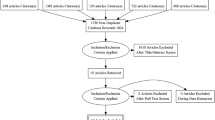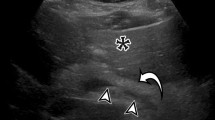Abstract
Purpose
Intraductal papillary neoplasms of the bile duct (IPNBs) are a group of rare lesions with uncertain clinical findings and imaging features. We aim to investigate the clinicopathological features and imaging findings of IPNBs on contrast-enhanced ultrasound (CEUS) and contrast-enhanced computed tomography (CECT).
Methods
From February 2005 to March 2018, 30 patients with pathologically confirmed IPNBs were retrospectively identified in our hospital. Demographic, clinical, and pathological data, CEUS and CECT features and surgical strategies were analyzed.
Results
The most common clinical manifestations were abdominal pain (53.3%), jaundice (23.3%), and acute cholangitis (10.0%). Among all lesions, 5/30 (16.7%) lesions presented as dilated bile ducts only, while 13/30 (43.3%) lesions presented as dilated bile ducts with intraductal papillary masses, and 12/30 (40.0%) presented as solid masses with dilated bile ducts. For the 20 patients who underwent both CEUS and CECT, 18 lesions were hyperenhanced on CEUS, and 17 lesions were hyperenhanced on CECT in the arterial phase. In total, 16 and 18 lesions showed washout in the portal and late phases on CEUS, while the corresponding number of lesions that showed washout in the portal and late phases on CECT were 11 and 13. Twelve lesions (40.0%) showed atypical hyperplasia, while 16/30 (53.3%) lesions underwent malignant transformations.
Conclusions
There are 3 major forms of IPNBs on grayscale ultrasound, including diffusely dilated bile ducts without visible mass; focal dilated bile duct with intraductal papillary masses; and solid mass surrounded by dilated bile ducts. The enhancement patterns of IPNBs on CEUS and on CECT were consistent. IPNB has a high malignant potential, and patients should be treated with surgical resection after the diagnosis is established.



Similar content being viewed by others
Abbreviations
- IPNB:
-
Intraductal papillary neoplasms of the bile duct
- CEUS:
-
Contrast-enhanced ultrasound
- CECT:
-
Contrast-enhanced computed tomography
- ICC:
-
Intrahepatic cholangiocarcinoma
- CPS:
-
Contrast pulse sequencing
- CHI:
-
Contrast harmonic imaging
- CA125:
-
Carbohydrate antigen 125
- CA19-9:
-
Carbohydrate antigen 19-9
References
Kassir R, Barabino G, Bageacu S, et al. (2013) Biliary papillomatosis in the common bile duct. Endoscopy 45 Suppl 2 UCTN:E197-198.
Loh A, Kamar S, Dickson GH (1994) Solitary benign papilloma (papillary adenoma) of the cystic duct: a rare cause of biliary colic. Br J Clin Pract 48(3):167-168.
Jung G, Park KM, Lee SS, et al. (2012) Long-term clinical outcome of the surgically resected intraductal papillary neoplasm of the bile duct. Journal of Hepatology 57(4):787-793.
Kim KM, Lee JK, Shin JU, et al. (2012) Clinicopathologic Features of Intraductal Papillary Neoplasm of the Bile Duct According to Histologic Subtype. Am. J. Gastroenterol. 107(1):118-125.
Rocha FG, Lee H, Katabi N, et al. (2012) Intraductal papillary neoplasm of the bile duct: A biliary equivalent to intraductal papillary mucinous neoplasm of the pancreas? Hepatology 56(4):1352-1360.
Ogawa H, Itoh S, Nagasaka T, et al. (2012) CT findings of intraductal papillary neoplasm of the bile duct: Assessment with multiphase contrast-enhanced examination using multi-detector CT. Clin. Radiol. 67(3):224-231.
Anthony PP (1994) Tumours and tumour-like lesions of the liver and biliary tract. Pathology of the liver, Third edition, ed. R.N.M. MacSween, et al. 1994: Churchill Livingstone, Edinburgh, Scotland, UK 650 Avenue of the Americas, New York, New York 10011, USA. 635-711.
Lee SS, Kim MH, Lee SK, et al. (2004) Clinicopathologic review of 58 patients with biliary papillomatosis. Cancer 100(4):783-793.
Takanami K, Yamada T, Tsuda M, et al. (2011) Intraductal papillary mucininous neoplasm of the bile ducts: multimodality assessment with pathologic correlation. Abdom Imaging 36(4):447-456.
Ohtsuka M, Shimizu H, Kato A, et al. (2014) Intraductal papillary neoplasms of the bile duct. Int J Hepatol 2014:459091.
Claudon M, Dietrich CF, Choi BI, et al. (2013) Guidelines and good clinical practice recommendations for Contrast Enhanced Ultrasound (CEUS) in the liver - update 2012: A WFUMB-EFSUMB initiative in cooperation with representatives of AFSUMB, AIUM, ASUM, FLAUS and ICUS. Ultrasound Med Biol 39(2):187-210.
Liu GJ, Xu HX, Lu MD, et al. (2006) Enhancement pattern of hepatocellular carcinoma: comparison of real-time contrast-enhanced ultrasound and contrast-enhanced computed tomography. Clinical imaging 30(5):315-321.
Vassiliou I, Kairi-Vassilatou E, Marinis A, et al. (2006) Malignant potential of intrahepatic biliary papillomatosis: a case report and review of the literature. World J Surg Oncol 4:71.
WHO classification of tumors of the digestive system, 4th ed. 2011, Ringgold, Inc.
Yeung YP, AhChong K, Chung CK, et al. (2003) Biliary papillomatosis: report of seven cases and review of English literature. J Hepatobiliary Pancreat Surg 10(5):390-395.
Ying S, Ying M, Liang W, et al. (2018) Morphological classification of intraductal papillary neoplasm of the bile duct. Eur Radiol 28(4):1568-1578.
Mourra N, Hannoun L, Rousvoal G, et al. (2002) Malignant intrahepatic biliary papillomatosis associated with viral C cirrhosis. Archives of Pathology & Laboratory Medicine 126(3):369-371.
Neumann RD, LiVolsi VA, Rosenthal NS, et al. (1976) Adenocarcinoma in biliary papillomatosis. Gastroenterology 70(5 PT.1):779-782.
Lamerz R (1999) Role of tumour markers, cytogenetics. Annals of Oncology 10:145-149.
Sakamoto K, Haga Y, Yoshimura R, et al. (1987) Comparative effectiveness of the tumour diagnostics, CA 19-9, CA 125 and carcinoembryonic antigen in patients with diseases of the digestive system.Gut 28(3):323-329.
Zen Y, Fujii T, Itatsu K, et al. (2006) Biliary cystic tumors with bile duct communication: a cystic variant of intraductal papillary neoplasm of the bile duct. Mod. Pathol. 19(9):1243-1254.
Liu LN, Xu HX, Zheng SG, et al. (2015) Ultrasound Findings of Intraductal Papillary Neoplasm in Bile Duct and the Added Value of Contrast-Enhanced Ultrasound. Ultraschall in der Medizin 36(6):594-602.
Sakamoto E, Nimura Y, Hayakawa N, et al. (1997) Clinicopathological studies of mucin-producing cholangiocarcinoma. J Hepatobiliary Pancreat Surg. 4(2):157-162.
Liu Y, Zhong X, Yan L, et al. (2015) Diagnostic performance of CT and MRI in distinguishing intraductal papillary neoplasm of the bile duct from cholangiocarcinoma with intraductal papillary growth. Eur Radiol 25(7):1967-1974.
Gordon-Weeks AN, Jones K, Harriss E, et al. (2016) Systematic Review and Meta-analysis of Current Experience in Treating IPNB: Clinical and Pathological Correlates. Ann Surg 263(4):656-663.
Kloek JJ, van der Gaag NA, Erdogan D, et al. (2011) A comparative study of intraductal papillary neoplasia of the biliary tract and pancreas. Hum Pathol 42(6):824-832.
Lim JH, Jang KT (2010) Mucin-producing bile duct tumors: radiological-pathological correlation and diagnostic strategy. J Hepatobiliary Pancreat Sci 17(3):223-229.
Acknowledgements
Financial Support: This study was funded by the National Nature Science Foundation of China (NO.81701701), Guangdong Nature Science Foundation (NO.2017A030313661,NO. 2016A030310143), Guangdong science and technology plan project (NO. 2017A020215195), Sun Yat-sen University young teachers training project(NO. 16YKPY37).
Author information
Authors and Affiliations
Contributions
Wei Wang and Bing Liao designed the research. Quan-Yuan Shan collected data; Ming Xu and Li-Da Chen evaluated the images and videos of US and CT. Hang-Tong Hu analyzed the data; Yang Huang edited tables and Figures; Qiao Zheng and Si-Min Ruan wrote the paper; Xiao-Yan Xie and Ming-De Lu edited the paper and polished the language.
Corresponding authors
Ethics declarations
Conflict of interest
The author declare that they have no competing interest.
Additional information
Publisher's Note
Springer Nature remains neutral with regard to jurisdictional claims in published maps and institutional affiliations.
Electronic supplementary material
Below is the link to the electronic supplementary material.
Rights and permissions
About this article
Cite this article
Zheng, Q., Ruan, SM., Shan, QY. et al. Clinicopathological findings and imaging features of intraductal papillary neoplasm of the bile duct: comparison between contrast-enhanced ultrasound and contrast-enhanced computed tomography. Abdom Radiol 44, 2409–2417 (2019). https://doi.org/10.1007/s00261-019-01987-4
Published:
Issue Date:
DOI: https://doi.org/10.1007/s00261-019-01987-4




